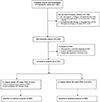Poor postnatal weight growth is a late finding after sepsis in very preterm infants
- PMID: 33148685
- PMCID: PMC8291375
- DOI: 10.1136/archdischild-2020-320221
Poor postnatal weight growth is a late finding after sepsis in very preterm infants
Abstract
Objective: To characterise the association between sepsis and postnatal weight growth when accounting for the degree of growth restriction present at birth.
Design: Retrospective matched cohort study using data from the Postnatal Growth and Retinopathy of Prematurity study. Participants were born with birth weights of <1500 g or gestational ages of <32 weeks between 2006 and 2011 at 29 neonatal centres in the USA and Canada. Sepsis was defined as a culture-confirmed bacterial or fungal infection of the blood or cerebrospinal fluid before 36 weeks' postmenstrual age (PMA). Growth was assessed as the change in weight z-score between birth and 36 weeks' PMA.
Results: Of 4785 eligible infants, 813 (17%) developed sepsis and 693 (85%) were matched 1:1 to controls. Sepsis was associated with a greater decline in weight z-score (mean difference -0.09, 95% CI -0.14 to -0.03). Postnatal weight growth failure (decline in weight z- score>1) was present in 237 (34%) infants with sepsis and 179 (26%) controls (adjusted OR 1.49, 95% CI 1.12 to 1.97). Longitudinal growth trajectories showed similar initial changes in weight z-scores between infants with and without sepsis. By 3 weeks after sepsis onset, there was a greater decline in weight z-scores relative to birth values in those with sepsis than without sepsis (delta z-score -0.89 vs -0.77; mean difference -0.12, 95% CI -0.18 to -0.05). This significant difference persisted until 36 weeks or discharge.
Conclusion: Infants with sepsis had similar early weight growth trajectories as infants without sepsis but developed significant deficits in weight that were not apparent until several weeks after the onset of sepsis.
Keywords: growth; microbiology; neonatology.
© Author(s) (or their employer(s)) 2021. No commercial re-use. See rights and permissions. Published by BMJ.
Conflict of interest statement
Competing interests: None declared.
Figures


References
-
- Horbar JD, Ehrenkranz RA, Badger GJ, et al. Weight Growth Velocity and Postnatal Growth Failure in Infants 501 to 1500 Grams: 2000–2013. Pediatrics. 2015;136(1):e84–e92. - PubMed
-
- Dusick AM, Poindexter BB, Ehrenkranz RA, Lemons JA. Growth failure in the preterm infant: can we catch up? Semin Perinatol. 2003;27(4):302–310. - PubMed
-
- Hack M, Breslau N, Fanaroff AA. Differential Effects of Intrauterine and Postnatal Brain Growth Failure in Infants of Very Low Birth Weight. Arch Pediatr Adolesc Med. 1989;143(1):63. - PubMed
-
- Stoll BJ, Hansen N. Infections in VLBW infants: Studies from the NICHD Neonatal Research Network. Semin Perinatol. 2003;27(4):293–301. - PubMed
-
- Stoll BJ, Hansen NI, Adams-Chapman I, et al. Neurodevelopmental and Growth Impairment Among Extremely Low-Birth-Weight Infants With Neonatal Infection. JAMA. 2004;292(19):2357. - PubMed
MeSH terms
Grants and funding
LinkOut - more resources
Full Text Sources
Medical
